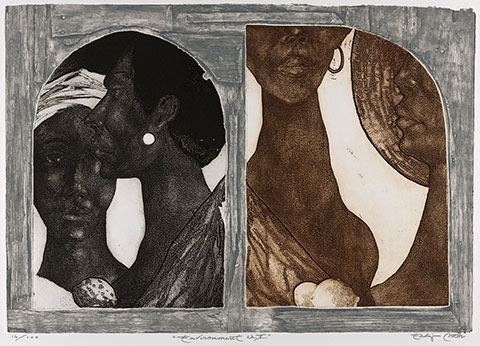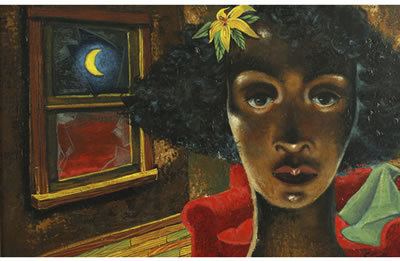Occupation Artist and printmaker Name Eldzier Cortor | Role Artist | |
 | ||
Died November 26, 2015, Long Island, New York, United States Awards Guggenheim Fellowship for Creative Arts, US & Canada | ||
Eldzier cortor coming home recent gifts to the art institute
Eldzier Cortor (January 10, 1916 – November 26, 2015) was an African-American artist and printmaker. His work typically features elongated nude figures in intimate settings, influenced by both traditional African art and European surrealism.
Contents
- Eldzier cortor coming home recent gifts to the art institute
- Early life
- Career
- Death
- Works
- Exhibitions and collections
- References

Eldzier cortor coming home recent gifts to the art institute
Early life

Cortor was born in Richmond, Virginia, to John and Ophelia Cortor. His family moved to Chicago when Cortor was about a year old, eventually settling in that city's South Side, where Cortor attended Englewood High School. Fellow students at Englewood included the African-American artists Charles Wilbert White and Margaret Burroughs. Cortor attended the Art Institute of Chicago, along with artist Gus Nall, gaining a degree in 1936. In 1940 he worked with the Works Progress Administration (WPA), where he drew scenes of Depression-era Bronzeville, a neighborhood on Chicago's South Side. In 1949, he studied in Jamaica, Cuba, and Haiti on a Guggenheim Fellowship, and taught at the Centre d'Art in Port-au-Prince from 1949 to 1951.

Growing up, he was an avid reader of the Chicago Defender, which was a popular newspaper that focused on celebrating the successes of African Americans. This is ultimately translated into the main thematic focus of his artwork, which is to portray African Americans in a positive light and highlight their beauty and achievements. For the majority of his career, Cortor played with different representations of the black female figure and how to represent her strength and beauty. Cortor saw the black female figure as being the essential spirit of the black race. His style is often described as experimenting with black physiognomy while infusing it with surrealism.
Career

In 1944 and in 1945, Cortor won two fellowships that allowed him to travel to the Sea Islands off the coast of Georgia and South Carolina. The Gullah people resided in these islands and Cortor was particularly interested in this area because of how untouched their culture had been by white people and American culture. In this regard, Cortor decided to explore a different African diasporic culture that had more African elements prevalent overall in their culture. He spent two years living on the islands and immersed himself into the Gullah culture. “As a Negro artist I have been particularly concerned with painting Negro racial types not only as such but in connection with particular problems in color, design and composition…I have felt an especial interest in…painting Negroes whose cultural traditions had been only slightly influenced by whites…I should like to…paint a series of pictures which would reflect the particular physical and racial characteristics of the Gullahs.”
Death
Cortor died on November 26, 2015, at the age of 99.
Works
Studying the African sculptures at an exhibit at the Field Museum transformed his work. He said "That was the most important influence in all my work, for to this day you will find in my handling of the human figure that clylindrical and lyrical quality I was taught...to appreciate in African art."
Cortor was one of the first African-American artists to make African-American women his dominant theme, explaining, "the Black woman represents the Black race, continuance of life." His treatment of women has been criticised, for instance in a 1985 article in Art, which described the figure in Southern Gate (1942–43) as, "Stripped of integrity and reduced to a mere object…" According to Adrienne Childs, Cortor’s Cuban Souvenir "presents an exoticized black woman whose red dress, red lips…evoke the stereotypical notion of the Latin female sexuality." (Childs 1998: 122).
Mel Edwards mentions Cortor as an example of an African-American artist influenced by surrealism, "who often uses the female figure in a surreal interior and exterior environment."
Cortor is considered to be the first African American artists to depict nude women as the central theme of his work. This was an unpopular choice for many artists at the time as a reaction to the dominant European and American cultural landscape at the time (Farrington 2004: 20). This was also unfavored because of the historical legacy of the sexual exploitation of black women during slavery. Cortor refutes these notions by showing the nude black female body as a source of strength. Cortor also believed that the black woman conveys a sense of eternity and continuance of life (Jennings 1988:, 47). An example of this is Cortor’s famous painting named Southern Gate, which is illustrated in Figure 2. The central figure to this painting is a young, naked black woman. The background of the painting is very dark; the gate is in ruins and the clouds are indicative of a storm. Immediately behind the woman, there are less clouds and more light, which illuminates her figure. The woman also has a flower in her hair and a bird on her shoulder, perhaps indicating the dawn of a new day. The figure in the painting stands stall, giving an overall sense of a triumphant figure still standing throughout the crumbling ruins and the resilience of black women in general (Dallow 2004:98).
Starting in the 1950s, Cortor became further inspired by African sculptures. In these works, one can see that he works more with cylindrical, graceful and elongated limbs. This is evident through Cortor’s painting Dance Composition No. 31, which was produced in 1978 as a part of a series. It is seen as a reflection of his time that he spent with the Gullah people. In this painting, he evokes basketry and dance, which were two activities considered essential to the Gullah people. The swirling lines and the subtle incorporation of vibrant colors implies a sense of visual movement of the dancers (Bearden 1993: 57). The women’s faces’ are depicted like sculptures, giving them a marble feel within the painting, referencing African art along with the decorative patterning. The sculptural women are also conveyed with a sense of peacefulness. This shows how important basket weaving and dancing are to the Gullah people and their culture.
Another example of this subtle shift in Cortor’s work is a painting of his named Classical Study No. 34 which was created in 1968 and also a part of a different series. In this painting, the woman is resting her head on her hand in a profile representation. Cortor plays with her features and makes them rather elongated, which gives a sculptural feel to the subject. She is also wearing a red, yellow and green scarf which is symbolic of the Pan-African flag, which pays homage to her African roots. The figure also resembles ancient marble sculptures, which were used in the past to celebrate someone. This painting is representative of celebrating the beauty and strength of black women, while emphasizing her African roots.
Exhibitions and collections
Cortor exhibited in the 1938 interracial show "An Exhibition in Defense of Peace and Democracy", which was sponsored by the Chicago Artists' Group. In 1940 he was one of the young artists exhibited at "The Exhibition of the Art of the American Negro" in Chicago. He also contributed to the 1967 City College of New York exhibition "The Evolution of Afro-American Artists: 1800 - 1950". In 1976 his painting Interior was included in the Los Angeles County Museum of Art exhibition "Two Centuries of Black American Art", curated by David Driskell, which toured the U.S in 1977. The 1988 group exhibition "Three Masters", at New York's Kenkeleba Gallery, featured Cortor's work alongside that of Hughie Lee-Smith and Archibald Motley. Michael Brenson, in The New York Times review of the show, expressed a preference for Cortor's still-life paintings, rather than his paintings of people. The solo show "Eldzier Cortor: Master Printmaker" was exhibited at the Boston Psychoanalytic Society and Institute in 2002. In 2010 his works were included in an exhibition at the Library of Congress, and a selection of his works on paper exhibited at the Indiana University Art Museum. In 2013 Cortor's prints were featured in an exhibition at the San Antonio Museum of Art
His works are held in the collections of Howard University, the Smithsonian American Art Museum and The Art Institute of Chicago, among others.
